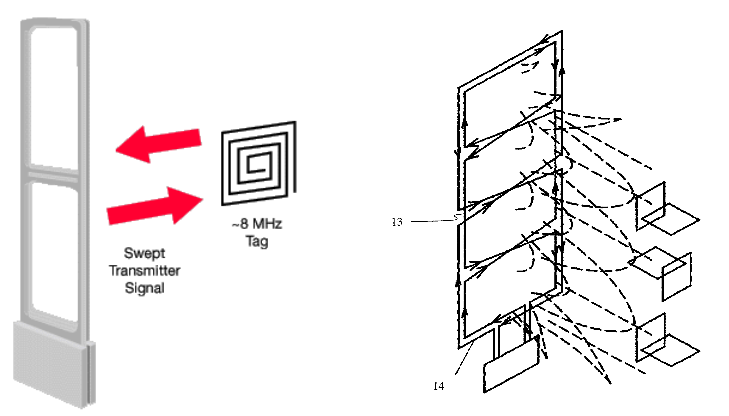Software for modeling magnetics at 8.2 MHz
I am looking for software tool to model EAS (electronic article surveillance) system ? so called swept RF systems with central frequency 8.2 MHz.
To re-phrase it in physical terms:
For closely spaced electrically small (x < λ/10) loops of different shapes I want to
- output spatial field distribution and determine field strength at different points in space
- determine coupling coefficient between the loops (S21)
- quantify effect of small resonant circuits placed in the vicinity of the loops on coupling coefficient (changes in S21 when resonant circuit is present).
Ideally software should have functionality to add discrete L-C-R components to the loops terminals ? to study effects of matching networks.
If anyone has experience with this type of problems please recommend good software tool.
Ideally looking for open source but commercial software is of some interest too.
Illustration of Electronic Article surveillance system

As you already pointed out, the EAS coils can be analyzed as pure AC magnetic problem, without coupling to far field.
The question has been often discussed related to wireless energy transfer problems. Suitable free and commercial are e.g. mentioned in this thread: https://www.edaboard.com/showthread.php?t=369972
You can separate the EM problem and the lumped elements, with no loss in accuracy. Just place ports where lumped elements are connected, and get the overall response by connecting EM results (Touchstone *.s?p) and lumped elements in a circuit simulator.
Most EM solvers that support lumped elements also include them in an internal postprocessing step, after solving the EM model.
FvM - that's a good insight: wireless charging is similar problem. The problem is almost purely magnetic radiation can be ignored at such small (in terms of wavelength) Still can not find software that does it conveniently. I tried CST - Transient solver takes hours to mesh, FD solver works sort of do not give me all the answers I need. Would be interesting to try Maxwell - I see many examples of wireless charging done on it but I do not have it.
FastHenry sounds interesting - where to get Windows install?
Modeling without matching components problematic. I need to evaluate range/sensitivity of the system and doing post processing for every data point takes lots of work. Doable of course ...
Just browse http://www.fastfieldsolvers.com/
A major FastHenry drawback is the lack of a convenient geometry editor.
I don't exactly understand the lumped components problem. It's straightforward to export a Spice model for the coil arrangement and use it in a regular circuit simulator. Particularly easy for small band problems.
I am working as an EM modelling expert since almost 20 years, including wireless charging optimization. My view: the beginner's approach to put "everything" straight into the EM model is the #1 reason for inefficient simulation and project delay.
Instead, I would at least start by separating the EM problem (EM model -> coupled coils) from the matching aspect, and use EM to investigate this as a coupled coil problem. The coupling mechanism is magnetic field coupling, so this solution is accurate. Bringing things to resonance doesn't change the conclusions from the coupled coil analysis.
But never mind, use whatever workflow you prefer.
try hfss. it is best frequency domain fem solver. you can include discrete component too in the fem solution or as external discrete component solved in the integrated circuit solver . Maxwell is an alternative only if you work with non linear ferromagnetic material. if you work with non saturating material , HFSS is more appropriate.
modeling Software magnetics 相关文章:
- High Frequency Resistor Modeling
- CST error Modeling and meshing operations may fail
- Transmission line modeling of resonant frequencies of a novel microwave resonator.
- modeling of a 3d function in CST
- 3D Modeling simulation of Active IPEM (Integrated PowerElectronic Module)for 1Mhz SRC
- Q3D modeling of a via array in a semiconducting substrate
